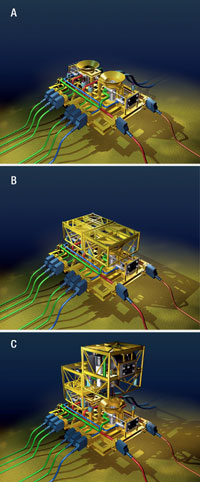 Technology from Europe: Technology from Europe:
United Kingdom
Complete subsea hydrocarbon processing system
Considerable progress has been made during the past year in building an autonomous subsea hydrocarbon processing system. As part of a 10-year design and development program, the 1999 ÆSOP Project demonstrated that hydrocarbon processing can be achieved by autonomous systems that are reprogrammable from a distant facility as field conditions warrant. The successful project further demonstrated that a complete offshore hydrocarbon processing system can be powered and controlled entirely by electricity, and that such a system can be housed in a readily deployable and retrievable System-Module. The Project consortium comprised Alpha Thames Ltd. of Upminster, UK; its parent company Kockums Engineering of Sweden; and Teamwork Technology of the Netherlands, with some funding from the Commission of the European Communities.
 |
Subsea manifold (a). Two early-production modules installed on manifolds for early production (b). A System-Module being installed for production processing, while second module continues production (c).
|
|
Shell and Alpha Thames’ latest efforts. The next phase of building an autonomous subsea hydrocarbon processing system is called AlphaPRIME. Shell Technology Ventures Ltd., with the assistance of the EP Projects division of Shell Int’l Exploration and Production Inc. (SIEP), and Alpha Thames, will carry out a 15-month program focused on qualifying technology for use in Shell Operating Units and field developments.
The companies agreed to manufacturing and testing of components for an AlphaCPU (Central Processing Unit – not to be confused with the computer term), to operate in 3,000-m deep water. This project will continue the development of an all-electric, modular, seabed processing unit system with “plug & play” capabilities that can be configured for two or three-phase seabed separation (oil, gas and water) and booster pumping of separated single-phase fluids, as well as for multiphase boosting.
The AlphaPRIME system is designed as modular, each with a 5-m x 4-m footprint that can be installed by diverless means, which allows incremental subsea development. The CPU system comprises a “dumb” docking manifold called KeyMAN, and System-Modules or FloCaps (see figure). For the option of early production, a FloCap is installed on the docking manifold. Later, a production module can replace the FloCap with appropriate separation, control and flow assurance equipment. Typically, each CPU is expected to handle about 20,000 bopd or 250 MMcfgd.
Operators can reprogram and re-adapt the system over time to match the reservoir’s production characteristics, such as increased water cut. In practice, each modular installation comprises at least two, identical operating systems, in parallel, which are mounted on a manifold. If field conditions change fundamentally, the System-Module can be retrieved and reconfigured to accommodate field conditions or to overhaul any of its existing components. This permits one entire System-Module to be retrieved, leaving the other on the seabed to maintain production.
This design approach also allows any new technology (including third party) to be incorporated within an existing system as it becomes available, thus providing maximum system flexibility to the operator. In this way, equipment is provisioned and deployed only when it is needed, thereby reducing the initial capital expenditure budget.
The qualification program will include manufacturing and testing of electrical subsea connectors, valve actuators and the CPU design. The program is expected to last until late this year with the objective of achieving a standard that qualifies the entire system as being “catalog ready” for potential offshore use by Shell. However, this does not preclude the technology from becoming available to other oil companies.
The agreement forms part of Shell EP Projects’ comprehensive global Subsea to Beach initiative, which is being implemented in collaboration with Shell Technology Norway and a broad spectrum of industry vendors worldwide. 
|

 Technology from Europe:
Technology from Europe:

